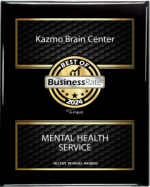Cognitive Behavioral Therapy (CBT) is an effective psychotherapy for a wide range of emotional and psychological problems, the basic tenet of CBT is that our emotions are affected by our cognitions. To put it another way the way we think affects the way we feel, CBT tends to deal with the ‘here and now’, how your current thoughts and behaviors are affecting you now, it perceives that events in your past have molded the way that you at present think and behave specifically, at childhood.
However, CBT doesn’t dwell on the past but aims to find solutions to changing your current thoughts and behaviors so that you can function better in the future, treatment depends on the simple idea that the way we think directly affects our behavior, so when we have irrational ideas, our behavior will also be irrational.
How Does Cognitive-Behavioral Therapy Begin?
During CBT meetings the advisor separates issues into little segments, which can be effectively managed each, in turn, a particular circumstance is the beginning stage; at that point, the individual’s quick defective contemplations about that circumstance are analyzed. These wrong frequently pessimistic considerations lead the individual to have certain feelings and physical emotions, which thusly prompts them to respond and carry on negatively.
Is Cognitive-Behavioral Therapy Effective?
Clinical trials suggest that CBT has been successful in addressing various emotional problems. For example, research studies have shown that a course of CBT is just as effective as medication in treating depression and certain anxiety disorders. It is also possible that longer-term, the effects of CBT will continue to protect the client from further illness. People who finish medication may be at greater risk of relapse compared to CBT clients, who have learned principles and strategies to sustain their recovery, so for example, problems such as depression or anxiety are less likely to recur in the future. There is also good research evidence to show that CBT can help to improve symptoms of some physical conditions such as rheumatoid arthritis.
What Does Cognitive-Behavioral Therapy Treat?
CBT is the most common treatment for clinical depression, eating disorders, and obsessive-compulsive disorders and is often beneficial to more common “life” problems such as stress, depression, anxiety, and low self-esteem. CBT can also treat more complex conditions such as: Bipolar Disorder & Relationships and Avoidant Personality Disorder. Sometimes, people find that anxiety and self-esteem problems grow to such a level that even performing simple tasks such as giving a presentation at work or even going to stores can affect their physical health and cause psychological distress, requiring a rapid intervention for CBT.
How Does CBT Differ From Other Types of Counseling?
The Evidence The most important distinguishing feature of CBT is the evidence that supports it, and a wealth of published research studies exist supporting its efficacy (e.g. Cochrane Review – a group of over 10,000 volunteers in more than 90 countries who review the effects of health care interventions tested in biomedical randomized controlled trials). CBT is the only psychotherapeutic approach with such a robust evidence base across a range of mental health problems.
Short Term Treatment. CBT is frequently presented as a ‘short term treatment’ and although in comparison to other types of ‘talking therapy’ it is certainly time-limited, it is important to dispel the myth that it offers a quick fix.
Problem Focused And Goal Oriented CBT focus on resolving specific problems. During the initial assessment, the therapist will develop a Problem Formulation which will enable both therapist and patient to understand how the problem has developed and why (up until this point) it has not been resolved. This formulation is then used to guide treatment towards specific goals (identified collaboratively by therapist and patient) that when reached will signify the resolution of the presenting problem.
Becoming Your Therapist The ultimate goal of CBT is for the patient to become their therapist. In CBT therapists and patients work together so that the patients can learn a set of skills (practical and psychological) that can be integrated with their existing knowledge so that they are eventually able to independently resolve not only current problems but tackle future ones without the need for additional counseling. This means that usually, only one course of treatment is necessary thus reducing the likelihood that ‘longer-term’ input will be needed.
CBT Therapy is often described as a ‘Here and Now’ therapy however it is important to be clear about what this means as this term is frequently misunderstood and used to imply that CBT is not suitable for resolving complex problems. In the initial phase of CBT, the focus is on alleviating the symptoms that the patients are currently experiencing (e.g. panic attacks, low mood) by addressing the factors that are maintaining them.
What you can Expect
Cognitive behavioral therapy may be done one-on-one or in groups with family members or with people who have similar issues. Online resources are available that may make participating in CBT possible, especially if you live in an area with few local mental health resources.
CBT often includes:
- Learning about your mental health condition
- Learning and practicing techniques such as relaxation, coping, resilience, stress management and assertiveness
Your First Therapy Session
At your first session, your therapist will typically gather information about you and ask what concerns you’d like to work on. The therapist will likely ask you about your current and past physical and emotional health to gain a deeper understanding of your situation. Your therapist may discuss whether you might benefit from other treatment as well, such as medications.
The first session is also an opportunity for you to interview your therapist to see if he or she will be a good match for you. Make sure you understand:
- His or her approach
- What type of therapy is appropriate for you
- The goals of your treatment
- The length of each session
- How many therapy sessions you may need
It might take a few sessions for your therapist to fully understand your situation and concerns, and to determine the best course of action. If you don’t feel comfortable with the first therapist you see, try someone else. Having a good “fit” with your therapist can help you get the most benefit from CBT.
During CBT
Your therapist will encourage you to talk about your thoughts and feelings and what’s troubling you. Don’t worry if you find it hard to open up about your feelings. Your therapist can help you gain more confidence and comfort.
CBT generally focuses on specific problems, using a goal-oriented approach. As you go through the therapy process, your therapist may ask you to do homework, activities, reading or practices that build on what you learn during your regular therapy sessions, and encourage you to apply what you’re learning in your daily life.
Your therapist’s approach will depend on your particular situation and preferences. Your therapist may combine CBT with another therapeutic approach. For example, interpersonal therapy, which focuses on your relationships with other people.
Steps in CBT
CBT typically includes these steps:
- Identify troubling situations or conditions in your life. These may include such issues as a medical condition, divorce, grief, anger or symptoms of a mental health disorder. You and your therapist may spend some time deciding what problems and goals you want to focus on.
- Become aware of your thoughts, emotions and beliefs about these problems. Once you’ve identified the problems to work on, your therapist will encourage you to share your thoughts about them. This may include observing what you tell yourself about an experience (self-talk), your interpretation of the meaning of a situation, and your beliefs about yourself, other people and events. Your therapist may suggest that you keep a journal of your thoughts.
- Identify negative or inaccurate thinking. To help you recognize patterns of thinking and behavior that may be contributing to your problem, your therapist may ask you to pay attention to your physical, emotional and behavioral responses in different situations.
- Reshape negative or inaccurate thinking. Your therapist will likely encourage you to ask yourself whether your view of a situation is based on fact or on an inaccurate perception of what’s going on. This step can be difficult. You may have long-standing ways of thinking about your life and yourself. With practice, helpful thinking and behavior patterns will become a habit and won’t take as much effort.
Length of Therapy
CBT is generally considered short-term therapy ranging from about five to 20 sessions. You and your therapist can discuss how many sessions may be right for you. Factors to consider include:
- Type of disorder or situation
- Severity of your symptoms
- How long you’ve had your symptoms or have been dealing with your situation
- How quickly you make progress
- How much stress you’re experiencing
- How much support you receive from family members and other people
Confidentiality
Except in very specific circumstances, conversations with your therapist are confidential. However, a therapist may break confidentiality if there is an immediate threat to safety or when required by state or federal law to report concerns to authorities. These situations include:
- Threatening to immediately or soon (imminently) harm yourself or take your own life
- Threatening to imminently harm or take the life of another person
- Abusing a child or a vulnerable adult ― someone over age 18 who is hospitalized or made vulnerable by a disability
- Being unable to safely care for yourself
Results
Cognitive behavioral therapy may not cure your condition or make an unpleasant situation go away. But it can give you the power to cope with your situation in a healthy way and to feel better about yourself and your life.
Getting the Most out of CBT
CBT isn’t effective for everyone. But you can take steps to get the most out of your therapy and help make it a success.
- Approach therapy as a partnership. Therapy is most effective when you’re an active participant and share in decision-making. Make sure you and your therapist agree about the major issues and how to tackle them. Together, you can set goals and assess progress over time.
- Be open and honest. Success with therapy depends on your willingness to share your thoughts, feelings and experiences, and on being open to new insights and ways of doing things. If you’re reluctant to talk about certain things because of painful emotions, embarrassment or fears about your therapist’s reaction, let your therapist know about your reservations.
- Stick to your treatment plan. If you feel down or lack motivation, it may be tempting to skip therapy sessions. Doing so can disrupt your progress. Attend all sessions and give some thought to what you want to discuss.
- Don’t expect instant results. Working on emotional issues can be painful and often requires hard work. It’s not uncommon to feel worse during the initial part of therapy as you begin to confront past and current conflicts. You may need several sessions before you begin to see improvement.
- Do your homework between sessions. If your therapist asks you to read, keep a journal or do other activities outside of your regular therapy sessions, follow through. Doing these homework assignments will help you apply what you’ve learned in the therapy sessions.
- If therapy isn’t helping, talk to your therapist. If you don’t feel that you’re benefiting from CBT after several sessions, talk to your therapist about it. You and your therapist may decide to make some changes or try a different approach.
Dr. Leza (Reza) Kazemi-Mohammadi, is the Kazmo Brain Center Director and Licensed Professional Counselor, and he uses CBT techniques. Visit us at Kazmo Brain Center for more information about Cognitive Behavioral Therapy.
Resource: The British cbt counseling







